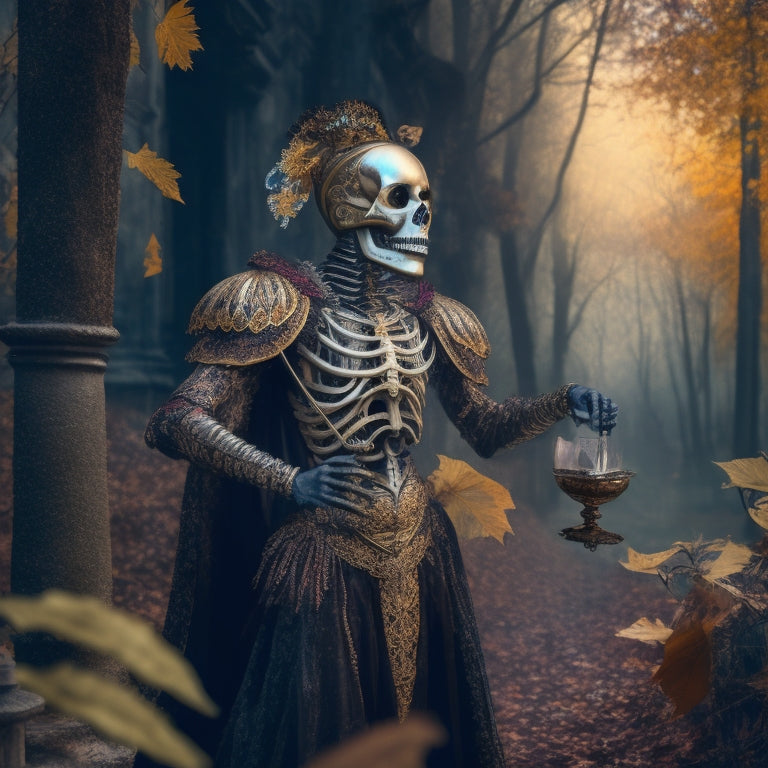
Dance of Death: A Timeless Symbol Explained
Share
The Dance of Death, a timeless symbol, serves as a poignant reminder of humanity's shared mortality, encouraging introspection and acceptance of our shared fate. Emerging in the late Middle Ages, this visual allegory has been adapted across artistic mediums and societal contexts, retaining its cultural significance. Transcending temporal and cultural boundaries, the Dance of Death motif conveys a universal message that mortality is an inescapable reality, prompting us to cherish the present moment. As we explore this symbol further, its profound implications and continued relevance will come into sharper focus, offering a nuanced understanding of our collective existence.
Key Takeaways
• The Dance of Death is a symbolic representation of mortality, encouraging introspection and mindfulness of life's preciousness and transience.
• Emerging in the late Middle Ages, the motif has been adapted to diverse artistic mediums and societal contexts, retaining its poignant message.
• The Dance of Death transcends temporal and cultural boundaries, conveying a universal message that mortality is an inescapable reality for all humanity.
• The symbolism holds contemporary relevance, reminding us to cherish the present and make the most of our fleeting lives.
• Through its versatility and cultural significance, the Dance of Death motif reflects the anxieties and fears of different eras, remaining a timeless symbol.
Unpacking the Memento Mori
The concept of memento mori, a Latin phrase translating to 'remember that you will die,' serves as a poignant reminder of humanity's shared mortality, urging individuals to reflect on their own transience and the preciousness of the present moment.
This symbolic representation of mortality encourages introspection, mindfulness, and appreciation for the fleeting nature of life. Through various artistic interpretations, memento mori has been depicted in diverse forms, from visual allegories to literary works, each conveying the universal message of mortality.
The Dance of Death Through Time
Emerging in the late Middle Ages as a visual allegory, the Dance of Death motif has traversed centuries, adapting to diverse artistic mediums and societal contexts while retaining its poignant reminder of mortality's universality.
Through its evolution, the Dance of Death has maintained its cultural significance, transcending temporal and spatial boundaries. From medieval frescoes to modern reinterpretations, this motif has demonstrated its versatility, reflecting the anxieties and fears of each era.
As a symbol, it has been recontextualized, yet its essence remains unchanged, serving as a powerful affirmation of mortality's universality. The Dance of Death's enduring presence is a confirmation of its power to evoke introspection and contemplation, ensuring its relevance across the ages.
Mortality's Universal Message
One of the most profound implications of the Dance of Death motif lies in its ability to transcend temporal and cultural boundaries, conveying a universal message that mortality is an inescapable reality that unites humanity across the ages.
This timeless theme speaks to the human experience, encouraging introspection and acceptance of our shared fate. The Dance of Death's symbolic imagery continues to hold contemporary relevance, reminding us to cherish the present and make the most of our fleeting lives.
-
Mortality's universal message fosters a sense of community, bridging cultural and temporal divides.
-
The Dance of Death serves as a poignant reminder to prioritize life's precious moments.
-
Symbolic imagery encourages a deeper understanding of our place within the human experience.
-
This motif's continued relevance underscores the importance of mindfulness and presence.
-
By confronting mortality, we may cultivate a greater appreciation for life's beauty and fragility.
Frequently Asked Questions
Can I Use Dance of Death Imagery in Modern Art Projects?
"Incorporating Dance of Death imagery in modern art projects can be a thought-provoking exercise, leveraging dark humor and sacred irony to prompt introspection, while cleverly subverting mortality's gravitas, inviting the viewer to confront and contemplate their own mortality."
How Did the Black Death Influence Dance of Death Artwork?
The Black Death's devastating mortality rates inspired artistic responses, as the Dance of Death emerged as a visual allegory, reminding everyone of mortality, and prompting introspection on the inevitability of death.
Are There Any Modern Adaptations of Dance of Death in Literature?
In modern literature, the Dance of Death inspires a Literary Revival, manifesting in Dark Fiction works that probe mortality, such as Neil Gaiman's "The Graveyard Book" and Joe Hill's "Heart-Shaped Box", which reinvigorate the allegory's macabre allure.
Can I Find Dance of Death Imagery in Contemporary Tattoos?
In contemporary tattoo culture, Dance of Death imagery is reimagined through dark aesthetics, infusing personal symbolism with mortality reminders, as tattoo enthusiasts seek to proclaim their existential awareness and defiance in the face of mortality.
Are There Any Religious Connotations to the Dance of Death Allegory?
"Carpe diem, for tomorrow is not guaranteed." The Dance of Death allegory, rooted in medieval Europe, bears no explicit religious connotations, instead serving as a secular Sacred Ritual, conveying Morality Tales that transcend faith, emphasizing mortality's universal significance.
Related Posts
-

Why Stunning Dance Makeup Matters in Photography
When you're capturing the dynamic energy of dance in a single frame, stunning dance makeup isn't just a nicety, it's ...
-

Unlock Your Creativity With Dancing Sublimation File
Dancing Sublimation File is a creative catalyst that opens up a world of vibrant design possibilities, providing high...
-

Mastering Dance Photography: Expert Tips and Techniques
You're about to excel in dance photography, a challenging field where only a few succeed. To join the elite 10%, you'...


